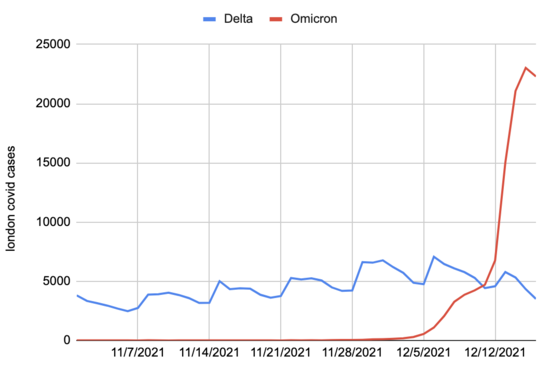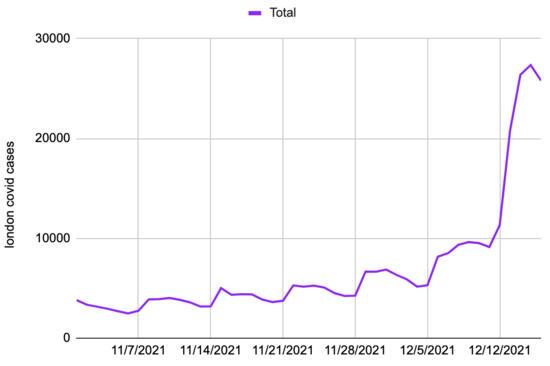Omicron Paths
post by jefftk (jkaufman) · 2021-12-20T18:30:04.651Z · LW · GW · 8 commentsContents
8 comments
While there is still a lot we don't know about Omicron, things are starting to come together. We know it is able to infect people who've previously had covid or been vaccinated, and that it spreads extremely quickly. Combine this with the US having very limited tracking of variants, and what should we expect to see?
Here's what cases look like in London:
London cases from coronavirus.data.gov.uk split by SGTF percentages from the Omicron daily overview. Inspired by Theo Sanderson's chart.
Now imagine that instead of seeing nice colored lines, you just saw a single line representing overall cases:
Instead of the rise in cases being apparent in the data from ~2021-12-01, it's not until ~2021-12-12 that we see it.
This is what the statistics will look like in places that don't know which cases are Omicron. It will look relatively flat, a small uptick which might be noise, and then a huge spike. And due to reporting delays, we won't see the spike until cases are much higher.
The biggest question in my mind is how we are going to react. Are we, as a society, going to seriously attempt to limit spread?
One potential path is that we don't. Vaccinated adults are in good shape, unvaccinated adults less so. Unvaccinated children were at a similar risk to vaccinated adults pre-Omicron. We don't shut things down and it burns through quickly. Hospitals probably get overloaded leading to additional deaths, especially of unvaccinated people.
Another potential path is that we really try: we go back to early 2020 policies, but at least this time we know to focus on air and not surfaces. Omicron is so infectious that I don't see how we contain it, and everyone still gets it eventually, but we have more time. This is the standard flattened curve, with fewer deaths due to the hospitals being less burdened, and the added potential benefit of Paxlovid approval (incredibly frustrating that it's still not even approved for emergency use) and scale up.
There are also paths in the middle, some of which makes sense. Every activity has some level of risk and some level of benefit, and the more we are able to move away from the ones with a bad ratio. The more we can gain time without giving up too much. In practice, however, I'm quite skeptical of this: our prioritization so far has been quite poor (indoor dining + remote elementary school!?) and while I would love to see improvement here, I'm not hopeful.
The White House is indicating pretty strongly that they're going for the first approach:
Our vaccines work against Omicron, especially for people who get booster shots when they are eligible. If you are vaccinated, you could test positive. But if you do get COVID, your case will likely be asymptomatic or mild.
We are intent on not letting Omicron disrupt work and school for the vaccinated. You've done the right thing, and we will get through this.
For the unvaccinated, you're looking at a winter of severe illness and death for yourselves, your families, and the hospitals you may soon overwhelm.
I think this last bit is an exaggeration: a large portion of unvaccinated people have already had covid. I'm also very interested in whether they will stick to this when cases start to skyrocket.
In terms of where this puts us as individuals, I think we also need to decide: how much are we willing to give up to avoid (or, more likely, postpone) catching Omicron? Getting a booster, if you haven't already, is worth it under a wide range of futures. The same goes for using good masks: cloth masks were a temporary stopgap while we scaled up production of better ones. N95s (and KN95s, KF94s, FFP2s, etc) all provide much better protection and are widely available, and even surgical masks are better than cloth.
Personally, I think gathering with vaccinated relatives and friends over the holidays is still worth it. There is some risk, including the risk that Omicron is already widespread here and we just don't know it yet, but the danger post-booster is low. I do recommend thinking through precautions and talking about them as a family: my extended family is planning to use rapid tests, air purifiers, and masks. We need to consider both sides of the balance, not just the increasingly large chance of an increasingly small harm, but also the value of seeing loved ones.
Comment via: facebook
8 comments
Comments sorted by top scores.
comment by Daniel Kokotajlo (daniel-kokotajlo) · 2021-12-20T19:17:53.439Z · LW(p) · GW(p)
We are intent on not letting Omicron disrupt work and school for the vaccinated. You've done the right thing, and we will get through this.
For the unvaccinated, you're looking at a winter of severe illness and death for yourselves, your families, and the hospitals you may soon overwhelm.
I wonder how the unvaccinated will react to this message. In today's politicized/polarized context, it sounds like deliberately-thinly veiled glee/schadenfreude.
Replies from: frontier64, Joe_Collman↑ comment by frontier64 · 2021-12-20T21:27:06.759Z · LW(p) · GW(p)
Definitely reads like a thinly veiled threat of some sort combined with a bit of fear-mongering. Especially given that factually, the statement looks false on its face, given that unvaccinated largely already have previous infection and Omicron seems more mild compared to other variants.
↑ comment by Joe Collman (Joe_Collman) · 2021-12-20T21:25:24.286Z · LW(p) · GW(p)
It certainly seems to be optimising for blame-avoidance rather than persuasion. I don't recall a "death for yourselves, your families, and the hospitals you may soon overwhelm" section in "How to win friends and influence people".
Presumably it's knee-jerk ass-covering and incompetence, rather than moustache-twirling villainy.
Either way, hard to imagine its having a net positive impact.
comment by ChristianKl · 2021-12-20T20:28:11.914Z · LW(p) · GW(p)
N95s (and KN95s, KF94s, FFP2s, etc) all provide much better protection and are widely available, and even surgical masks are better than cloth.
Good FFP3 (equivalent for N99) are available https://smile.amazon.de/-/en/Aura-Respirator-9330-Folding-Unvalved/dp/B00VAT74NG/ref=sr_1_3?crid=2FHXM7CKD66WS&keywords=aura+3m+9330&qid=1639930225&s=industrial&sprefix=3m+aura+9330%2Cindustrial%2C73&sr=1-3
Replies from: jkaufman↑ comment by jefftk (jkaufman) · 2021-12-20T22:08:06.873Z · LW(p) · GW(p)
Unless you are fit testing (and shaving, if you would normally have interfering facial hair) is FFP3/N99 worth it over FFP2/N95? I had been guessing not? The idea is, almost all of the particles you are likely to encounter are ones that get around the mask and not through it.
Replies from: ChristianKl↑ comment by ChristianKl · 2021-12-20T22:45:05.633Z · LW(p) · GW(p)
I haven't done a proper fit test (sadly not easily available for nonmedical personal), but wearing the linked mask feels like it's actually designed to fit while the people that make the normal respirator didn't think about how to design a respirator so that it fits.
While having no eyewear fogging itself isn't a sign that it perfectly seals, but I never eyewear fogging with the 3M Aura 9330 and had it regularly with standard FFP2 masks.
The following video shows the basic design of the family of 3M resperiators and how their helps with getting a good fit. The video does suggest that facial hair isn't ideal but I expect that still most of the air goes through the respirator.
↑ comment by jefftk (jkaufman) · 2021-12-20T23:27:48.203Z · LW(p) · GW(p)
Sure, but if 90% of the air is going through the respirator then N95 gets you 86% filtration while N99 gets you 89%. Which makes me think that once you get to a mask that does serious filtering, the main consideration is how well it fits? Which varies a lot: I've tried several different and 95 masks, and now have one that I feel fits pretty well on my face.
comment by Asgård · 2021-12-20T19:15:34.180Z · LW(p) · GW(p)
I agree with a lot of this post, and think it's well written, thanks for overlay of Delta and Omicron numbers, I hadn't thought too much about the lack of variant tracing in America and what that means for their reaction times.
I do agree with the gist, (though I don't know your family, their precautions seem very reasonable) that depending on your situation, it's safe to meet for the holidays. I disagree with your assessment of it being an increasingly large risk of an increasingly small harm, though maybe we just have different lengths of time that we're looking at. I think that with the likelihood of an overwhelmed medical system climbing along with the chance of infection, I'd assess it as more of an increasingly large risk of an increasingly large harm.
I don't have (and can't have) these numbers in front of me, but I can imagine a boosted Bob in January, at the theoretical peak of Omicron, having a higher chance of [serious outcomes] than a vaccinated Vicki in November, just because once hospitalized, the treatment will be much poorer around January. Would be interested in people's feelings/actual numbers on this.

